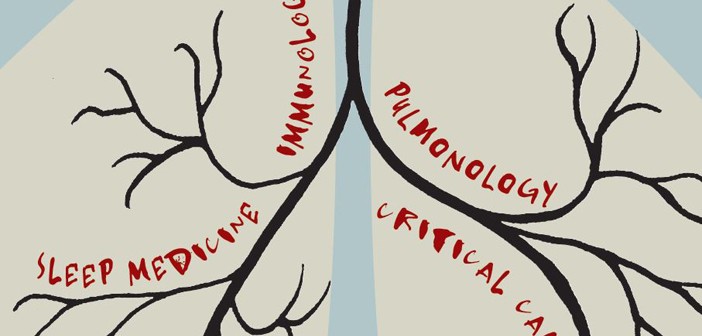Bench to Bedside
Even before his efforts with BIRDs, Elias was a strong proponent of translational research. This is exemplified by the basic and clinical research that has been done in his lab and the focus of his group, which he calls “from mice to man and back again.” In conjunction with his research partner of almost 20 years, Professor of Molecular Microbiology and Immunology Chun Geun Lee, MD, PhD, the lab has done seminal work to decipher the molecular mechanisms that control injury and repair in healthy people and how these responses behave abnormally in patients with diseases. They have used mice and other experimental systems to figure out the basic mechanisms that mediate injury and repair and then focused on asthma, chronic obstructive lung disease (COPD), pulmonary fibrosis, and even lung cancer to define the importance of these pathways in these diseases. One of the approaches they frequently employ is the generation and characterization of genetically modified mice. According to Elias, Lee is a “master chromosome carpenter,” an expert in making genetically modified mouse models of human respiratory diseases. “He can take any gene that you want—he can knock it out, overexpress it in the lung, and can make mice that allow an investigator to turn the gene on and off whenever he or she wants,” Elias says. “I have been blessed to work with him.”
From experiments with both mouse models and patients, Elias and Lee discovered that one protein—chitinase 3-like-1 (CHI3L1)—is implicated in a host of respiratory problems. In typical individuals, CHI3L1 is induced after injury, where it feeds back to decrease lung injury while augmenting lung repair. But they also found that this essential gene and its pathway are “monstrously abnormal” in many of their mouse models of respiratory diseases and the corresponding human disorders.
Asthma is one of the diseases where CHI3L1 is most abnormal. Their studies demonstrated that it is increased in the circulation of patients with severe asthma, where it contributes to the exaggeration of asthmatic inflammation. To see if mutations in this gene cause respiratory problems in humans, Elias and colleagues studied the CHI3L1 genes in members of a religious group called the Hudderites, who live together in an agrarian community and share property equally (“if one person gets a new wheat thresher, everybody gets a new wheat thresher,” Elias says). They were chosen because their lifestyle minimizes “gene by environment interactions,” allowing genetic effects to be readily appreciated. Consistent with the mouse models and other human studies, the researchers found that specific individual-toindividual variations in the CHI3L1 genes in the Hudderites correlated with the prevalence of asthma and abnormal lung function.
In additional studies, Elias, Lee, Chuan Hua He, PhD, assistant professor of molecular microbiology and immunology, and the team discovered receptors for CHI3L1 and, with Yang Zhou, PhD (also an assistant professor in that department), discovered a genetic form of pulmonary fibrosis that is caused by abnormal trafficking and activity of a receptor protein that interacts with CHI3L1. They also have early evidence from a collaboration with Juan Sanchez- Esteban, MD, professor of pediatrics, that CHI3L1 may be important for lung development in premature infants.
Lee says this protein is likely involved in additional biological processes. “We now understand that it is not just important in the lung. It also appears to be involved in systemic diseases, including some metabolic disorders,” he says. “It is really a fundamental molecule with a long evolutionary history in diverse species.”
“Our dream,” Elias says, “is that we make basic discoveries, we then evaluate their importance in the pathogenesis of the diseases that affect our patients, and then, when appropriate, work with pharmaceutical companies and or venture capital investors to turn these discoveries into therapies.”
Lee and Elias are well on their way to making this dream a reality in their CHI3L1 work. In conjunction with colleagues at Yale, they recently received one of 10 CADET (Centers for Advanced Diagnostics and Experimental Therapeutics in Lung Disease) grants awarded by the NIH. “We have an antibody against the human form of chitinase 3-like-1, and the grant provides funding that will allow us to make it into a drug for asthma,” Elias says.
He hopes to develop such translational work via BIRDs. “We want to be a nationally and internationally recognized place where new concepts of disease pathogenesis are discovered and then turned into new therapies,” he says.
The recruitment of new respiratory researchers and the formation of new BIRDs-inspired collaborations are already beginning to bear fruit. “A couple years ago there was very little research in terms of NIH dollars in respiratory diseases; now there’s a multimilliondollar research portfolio in respiratory diseases … and it’s just beginning to grow. The synergies between people that have already occurred are just the tip of the iceberg,” Elias says.
“The beauty of it is that we now have impressive strengths in asthma, pulmonary hypertension, pulmonary fibrosis, COPD, lung cancer, lung development and pediatric lung diseases, and sleep apnea. It’s a really exciting time for all of us.”




